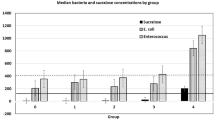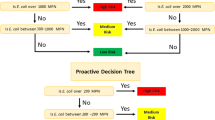Abstract
Fecal contamination of water is a public health concern for those using the water for drinking or recreation. The EPA recommends using Escherichia coli to evaluate recreational freshwaters for fecal contamination. With limited resources available, states have recently focused on training volunteers to expand data collection and resource assessment. Several bacteria testing methods are available for use by the public; however, few studies have comprehensively evaluated their use by volunteers. This study evaluated two E. coli monitoring methods used by volunteers: Coliscan Easygel® and 3MTM PetrifilmTM, incubated for 24 and 48 hours. The methods were assessed to determine how closely each matched results with EPA-approved laboratory analyses. Analysis of covariance results indicated that when used by volunteers to monitor surface water, 3MTM PetrifilmTM results were more similar to laboratory analyses than Coliscan Easygel®. Both test methods had similar overall accuracy of predicting if a sample exceeded or fell below the 235 cfu/100 mL EPA body contact standard for recreational surface waters. Two-thirds of volunteers preferred 3MTM PetrifilmTM.
Similar content being viewed by others
References
3M (2008a). 3M PetrifilmTM Coliform Count plate interpretation guide. http://multimedia.3m.com/mws/mediawebserver?66666UuZjcFSLXTt4XMa4XM_EVuQEcuZgVs6EVs6E666666–. Accessed 16 December 2008.
Beloti, V., de Souza, J. A., de Aguiar Ferreira Barros, M., Nero, L. A., de Mattos, M. R., Gusmão, V. V., et al. (2003). Evaluation of PetrifilmTM EC and HS for total coliforms and Escherichia coli enumeration in water. Brazilian Journal of Microbiology, 34(4), 301–304.
Canfield, D. E., Jr., Brown, C. D., Bachmann, R. W., & Hoyer, M. V. (2002). Volunteer lake monitoring: testing the reliability of data collected by the Florida LAKEWATCH program. Lake and Reservoir Management, 18(1), 1–9.
Clark, M. L., & Gamper, M. E. (2003). A synoptic study of fecal-indicator bacteria in the Wind River, Bighorn River, and Goose Creek Basins, Wyoming, June to July 2000. Water resources investigations report 03-4055. US Department of the Interior, US Geological Survey.
Cohn, J. P. (2008). Citizen science: Can volunteers do real research? BioScience, 58(3), 192–197.
Costerton, J. W., Geesey, G. G., & Cheng, K. J. (1978). How bacteria stick? Scientific American, 238(1), 86–95.
Deutsch, W. G., & Busby, A. L. (1999). Alabama water watch quality assurance plan for bacteriological monitoring. Alabama Water Watch, Auburn University, AL (63 pp). https://aww.auburn.edu/Docs/manuals/QABacManual99.pdf. Accessed February 25, 2010.
Ely, E., & Hamingson, E. (1998). National directory of volunteer environmental monitoring programs (5th Edn.). Washington, DC: United States Environmental Protection Agency.
Engel, S. R., & Voshell Jr., J. R. (2002). Volunteer biological monitoring: Can it accurately assess the ecological condition of streams? American Entomologist, 48(3), 164–177.
Lear, G., Anderson, M. J., Smith, J. P., Boxen, K., & Lewis, G. D. (2008). Spatial and temporal heterogeneity of the bacterial communities in stream epilithic biofilms. FEMS Microbiology Ecology, 65(3), 463–473.
Micrology Laboratories (2008). Detection of waterborne coliforms and E. coli with Coliscan Easygel. http://www.micrologylabs.com/Home/Our_Methods/Coliscan_Easygel/Coliscan_Easygel_Instructions. Accessed 16 December 2008.
Nerbonne, J. F., & Vondracek, B. C. (2003). Volunteer macroinvertebrate monitoring: Assessing training needs through examining error and bias in untrained volunteers. Journal of the North American Benthological Society, 22(1), 152–163.
Noble, R. T., Weisberg, S. B., Leecaster, M. K., McGee, C. D., Ritter, K., Walker, K. O., et al. (2003). Comparison of beach bacterial water quality indicator measurement methods. Environmental Monitoring and Assessment, 81, 301–312.
O’Brien, E. (2006). Volunteers conduct bacteria methods study. The Volunteer Monitor, 18(1) 3–6.
O’Leary, N., Wagenet, L., Pfeffer, M., & Vawter, T. (2002). Linking science and the public: Monitoring water quality of streams. American Water Resources Association Annual Conference. Philadelphia, PA. November 4–7, 2002.
Obrecht, D. V., Milanick, M., Perkins, B. D., Ready, D., & Jones, J. R. (1998). Evaluation of data generated from lake samples collected by volunteers. Lake and Reservoir Management, 14(1), 21–27.
Pope, M. L., Bussen, M., Feige, M. A., Shadix, L., Gonder, S., Rodgers, C., et al. (2003). Assessment of the effects of holding time and temperature on Escherichia coli densities in surface water samples. Applied and Environmental Microbiology, 69(10), 6201–6207.
Robertson, D. M., Weigel, B. M., & Graczyk, D. J. (2008). Nutrient concentrations and their relations to the biotic integrity of nonwadeable rivers in Wisconsin: US Geological Survey Professional Paper 1754, p. 81.
Selvakumar, A., Borst, M., Boner, M., & Mallon, P. (2004). Effects of sample holding time on concentrations of microorganisms in water samples. Water Environment Research, 76(1), 67–72.
Umble, A. K., Kolo, L. E., Newvine, L. A., Roth, G. N. & Roth, J. N. (1999). Coliform counts. Water Environment & Technology, 11(4), 57–59.
USEPA (1986a). Quality criteria for water—1986. EPA-440/5-86-001, Washington, DC.
USEPA (1986b). Ambient water quality criteria for bacteria—1986. US Environmental Protection Agency. EPA-440/5-84-002.
USEPA (1999). Action plan for beaches and recreational waters: reducing exposures to waterborne pathogens. EPA/600/R-98/079. Washington, DC: Office of Water, US Environmental Protection Agency.
USEPA (2000). Beaches Environmental Assessment and Coastal Health Act of 2000. Public law 106–284. http://www.epa.gov/waterscience/beaches/files/beachbill.pdf. Accessed March 29, 2010.
USEPA (2002). Method 1603: Escherichia coli (E. coli) in water by membrane filtration using modified membrane-thermotolerant Escherichia coli agar (modified mTEC). EPA 821-R-02-023. Washington, DC: Office of Water, US Environmental Protection Agency.
USEPA (2003). Bacterial water quality standards for recreational waters (freshwater and marine waters) status report. http://www.epa.gov/waterscience/beaches/local/statrept.pdf. Accessed 1 September 2009.
USEPA (2006a). Overview of current total maximum daily load—TMDL—program and regulations. http://www.epa.gov/owow/tmdl/. Accessed 30 June 2008.
USEPA. (2006b). Method 1103.1: Escherichia coli (E. coli) in water by membrane filtration using membrane-thermotolerant Escherichia coli Agar (mTEC). EPA-821-R-06-010. Washington, DC: Office of Water, US Environmental Protection Agency.
Vail, J. H., Morgan, R., Merino, C. R., Gonzales, F., Miller, R., & Ram, J. L. (2003). Enumeration of waterborne Escherichia coli with Petrifilm plates: comparison to standard methods. Journal of Environmental Quality, 32, 368–373.
Author information
Authors and Affiliations
Corresponding author
Rights and permissions
About this article
Cite this article
Stepenuck, K.F., Wolfson, L.G., Liukkonen, B.W. et al. Volunteer monitoring of E. coli in streams of the upper Midwestern United States: a comparison of methods. Environ Monit Assess 174, 625–633 (2011). https://doi.org/10.1007/s10661-010-1483-7
Received:
Accepted:
Published:
Issue Date:
DOI: https://doi.org/10.1007/s10661-010-1483-7




